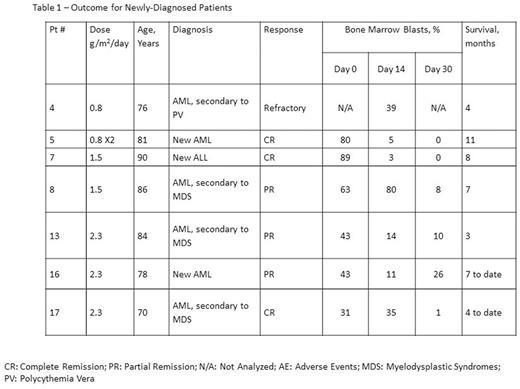Abstract
Introduction: Therapy of acute myeloid leukemia (AML) has not changed significantly during several decades. High-dose cytarabine, although used as the first-line treatment for AML since 1970s and as a second-line treatment for acute lymphoblastic leukemia (ALL), is associated with severe side effects, such as cerebellar toxicity and bone marrow suppression. Hence, while the incidence of AML increases with age, doses of cytarabine are significantly attenuated or the drug is entirely excluded from the regimen used in older adults due to its potential toxicities, particularly in individuals with hepatic or renal dysfunction.
Astarabine is a new composition of cytarabine covalently bound to asparagine. It is designed to target cytarabine to leukemic blasts, thus avoiding extramedullary toxicity. Leukemic cells, which are dependent on an external source of amino acids in general and asparagine in particular, due to their high metabolic rate, have a relatively increased uptake of Astarabine. Inside the blasts, Astarabine is cleaved to cytarabine, enabling targeted killing and relative sparing of normal hematopoiesis. As such, Astarabine may serve as an ideal therapy for leukemia, particularly for delivering high doses of cytarabine to medically unfit or older adults who otherwise can be given supportive therapy only. The aim of this study was to evaluate the safety and optimal dose of Astarabine in refractory/relapsed or medically unfit patients with acute leukemia.
Methods: This Phase I/IIa prospective open label study enrolled patients aged ≥18 years with relapsed/refractory or newly-diagnosed acute leukemia unfit for intensive therapy, as judged by the treating physician. The study was approved by the Rambam IRB (approval #0384-11). Patients were enrolled into 6 Astarabine escalating-dose cohorts, each composed of 3-6 patients. Treatment was administered as a 1-hour single daily infusion for 6 days. For cohorts 1-4, Astarabine doses for each infusion were 0.5g/m2, 1.5g/m2, 3g/m2 and 4.5g/m2. The doses were reduced by 50% for patients >50 years. Since dose limiting toxicity (DLT) was not reached in cohorts 1-4, the study was extended to include cohorts 5 and 6 with daily Astarabine doses of 4.5g/m2 and 6g/m2, respectively, with no dose reduction for patients >50 years old.
Results: The outcome of 15 patients is reported herein. Six patients with a median age of 64 years (range 27-81) had refractory/relapsed AML, 9 patients with a median age of 80 years (range 70-90) were newly diagnosed (secondary AML - 6, de-novo AML - 2, de-novo ALL - 1) and unfit for intensive therapy. Astarabine treatment was well-tolerated. Two patients died (one from pneumonia and one from sudden death 2 weeks from end of treatment) before completing 30 days post-treatment and hence were excluded from the outcome analysis. Response to the treatment was observed in the bone marrow of 6 of the 7 newly-diagnosed patients for whom bone marrow analysis was available, 3 of whom had a continuous complete remission (CR) for 4 (ongoing), 8, and 10 months post-treatment, and 3 had a continuous partial remission (PR) for 3,7, and 7 (ongoing) months. The median overall survival (OS) of the patients with CR/PR is 7 months to date (table 1). No significant response was observed in the relapsed/refractory patients, with a median OS of 2.5 months. Twelve patients died from disease progression.
Conclusions: Astarabine, a new composition of leukemia-targeted cytarabine, is safe and very well tolerated, even in patients over 80 years of age, resulting in response in 6 of 7 newly diagnosed patients with acute leukemia. To the best of our knowledge, this is the first report permitting high-dose of cytarabine, considered a cornerstone of leukemia therapy, to be given to a population of patients that heretofore did not have this option. Further dose escalation studies are currently ongoing at a cytarabine-equivalent dose of 4.5 and 6 g/m2/day. A phase II study is planned to confirm these encouraging results and define the use of Astarabine for patients otherwise unable to receive high doses of cytarabine.
Zuckerman:BioSight Ltd: Consultancy, Research Funding. Gengrinovitch:BioSight Ltd: Employment, Equity Ownership, Patents & Royalties: Inventor all of the patents. Ben-Yakar:BioSight Ltd: Consultancy, Employment, Equity Ownership, Membership on an entity's Board of Directors or advisory committees, Patents & Royalties: Inventor of all patents.
Author notes
Asterisk with author names denotes non-ASH members.


This feature is available to Subscribers Only
Sign In or Create an Account Close Modal